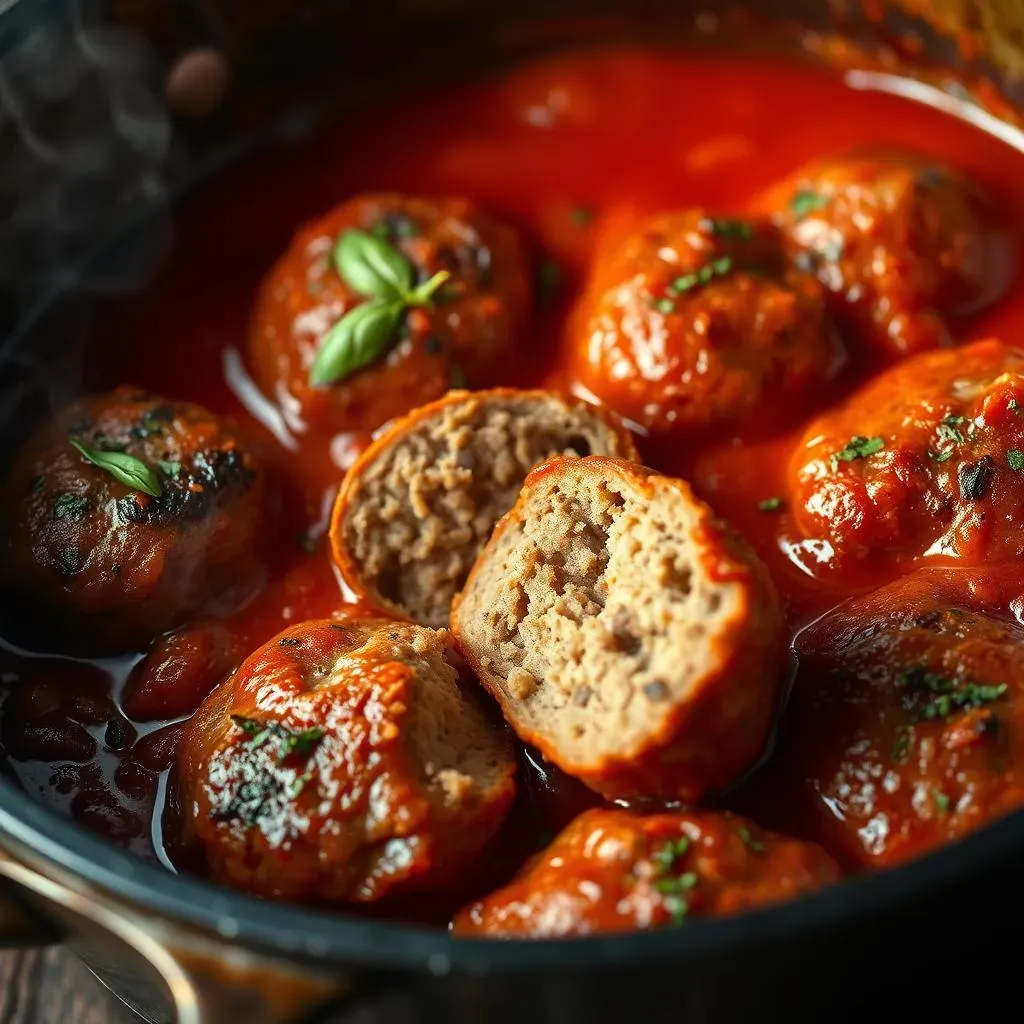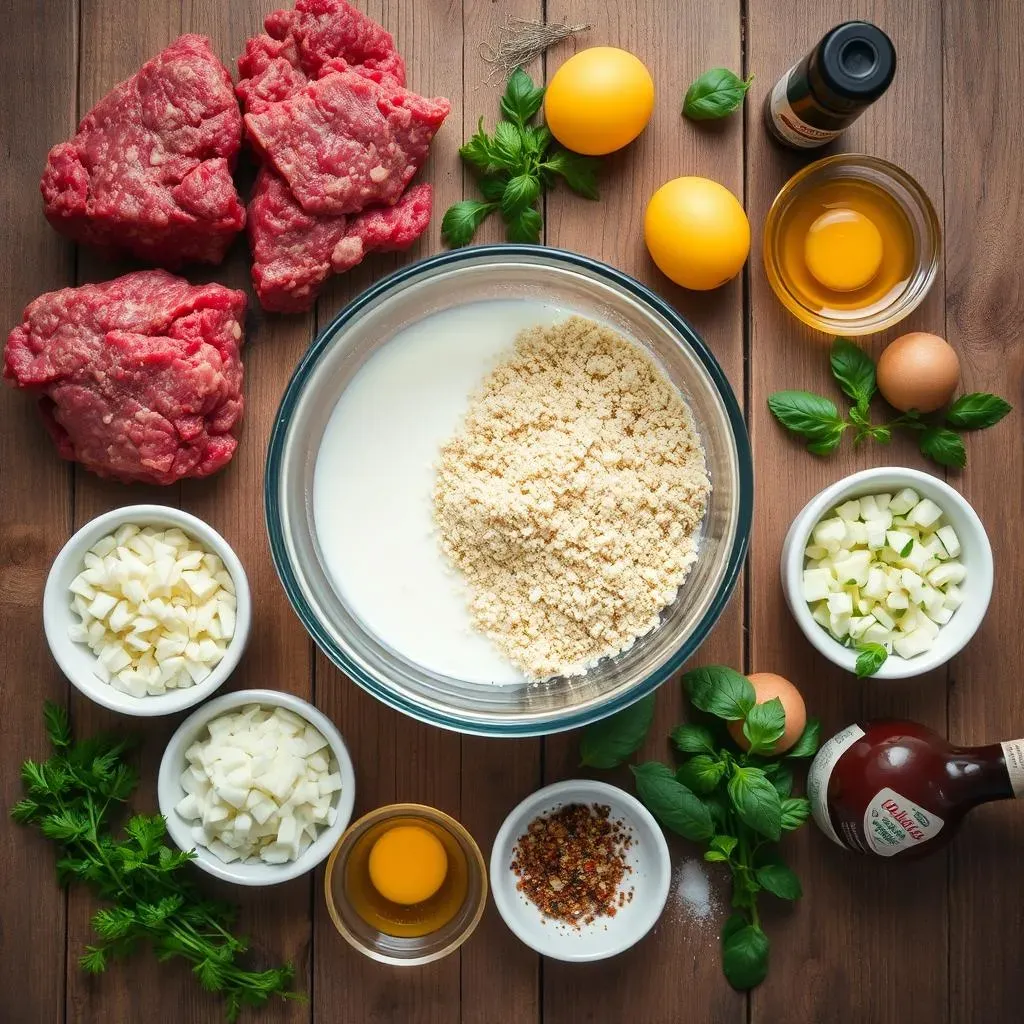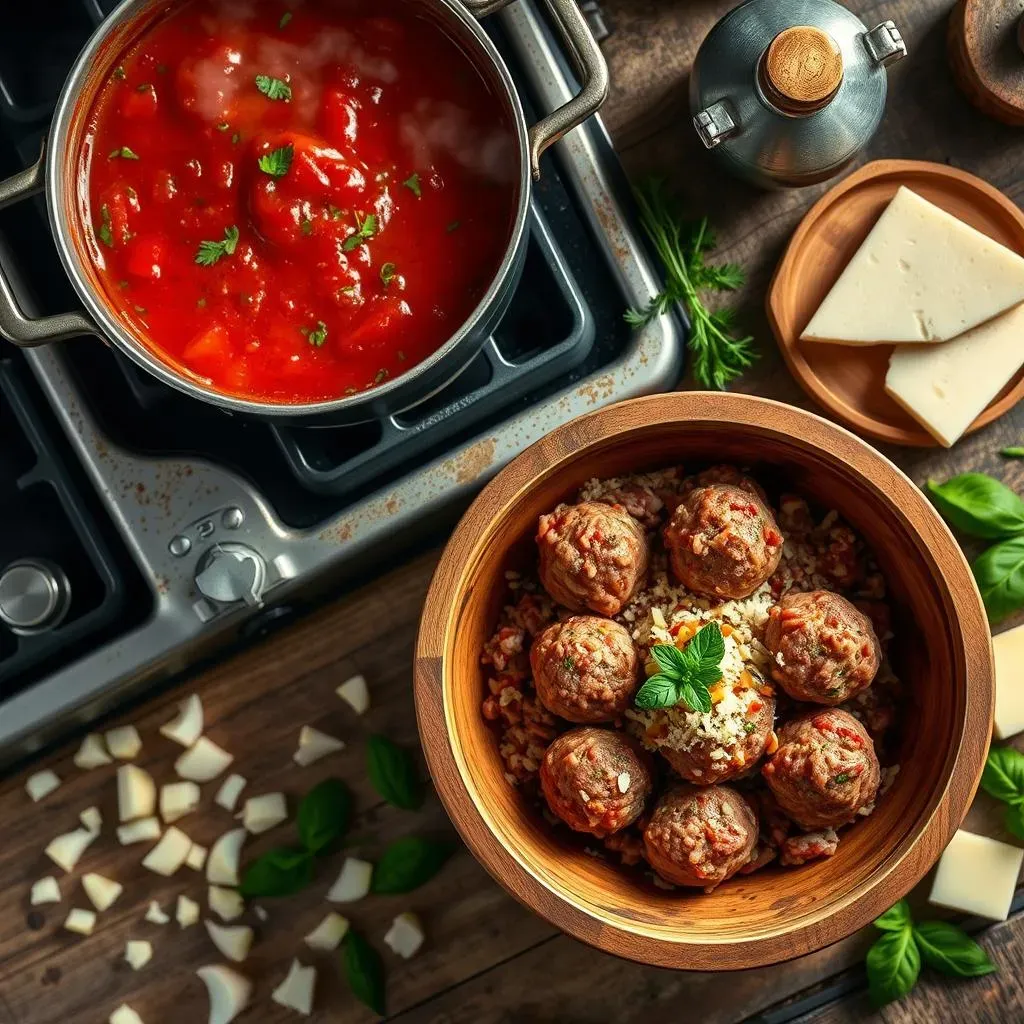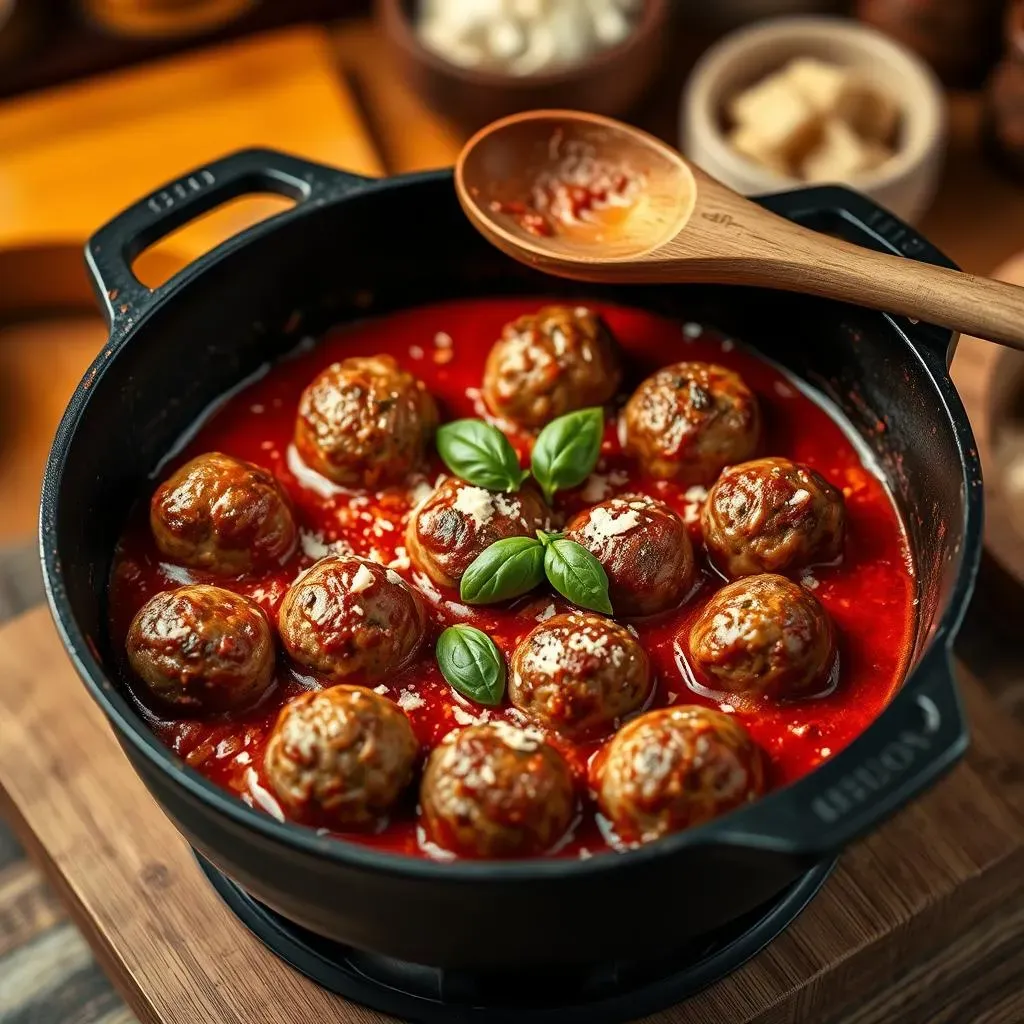Craving that perfect plate of spaghetti and meatballs? Forget dry, flavorless meatballs. We're diving headfirst into the secrets of a truly good italian meatball recipe, one that will have your family begging for seconds. This isn't just another recipe; it's a journey to meatball mastery, combining time-tested techniques with a bit of kitchen science to guarantee juicy, tender results every single time. Think of your grandma's classic recipe, but with a few modern tweaks for guaranteed success. We'll break down the key ingredients, explain why they matter, and walk you through each step of the process, from mixing to simmering in a rich tomato sauce. Get ready to learn how a simple breadcrumb trick can transform your meatballs from ordinary to extraordinary. Plus, we'll tackle common meatball mishaps and answer all your burning questions. So, grab your apron, and let's get cooking! By the end of this, you'll have the ultimate good italian meatball recipe in your arsenal, ready to impress even the toughest critics.
Why This Italian Meatball Recipe Works

Why This Italian Meatball Recipe Works
The Science of Tender Meatballs
Ever wonder why some meatballs are tough and dry, while others are melt-in-your-mouth tender? It all comes down to a few key principles. This recipe nails it because it focuses on moisture retention and flavor development. The secret weapon? A panade – a mixture of breadcrumbs and milk (or eggs). This seemingly simple addition is a game-changer, acting like a sponge to trap meat juices during cooking.
Think of it like this: when meat cooks, it contracts, squeezing out moisture. The panade provides an alternative source of liquid, keeping the meatball plump and juicy. Also, broiling the meatballs before simmering isn't just for show. It's about creating a flavorful crust through the Maillard reaction, that magical browning process that unlocks hundreds of delicious flavor compounds.
A Nod to Tradition, Perfected
This recipe isn't just about science; it's also rooted in Italian tradition. For generations, Italian cooks have known that slow simmering in tomato sauce is the key to truly tender meatballs. The long, gentle cooking process allows the flavors to meld together, creating a depth of flavor that you just can't achieve with quick cooking methods.
This recipe builds on that foundation, using high-quality ingredients and proven techniques to deliver a meatball that's both familiar and exceptional. It's the kind of recipe that gets passed down through families, with each cook adding their own personal touch. In fact, you can think of this recipe as a great starting point to create your own signature meatball recipe.
Key Element | Why It Works |
|---|---|
Panade (Breadcrumbs & Milk) | Retains moisture, prevents dryness |
Broiling | Develops flavor, creates a crust |
Slow Simmering | Tenderizes meat, melds flavors |
Ingredients for the Perfect Italian Meatballs

Ingredients for the Perfect Italian Meatballs
The Meat: The Foundation of Flavor
Let's talk meat, the heart and soul of any good italian meatball recipe. While you can absolutely use 80-85% lean ground beef for a classic flavor, don't be afraid to experiment. A mix of meats can add incredible depth. Ground pork brings richness and moisture, while ground veal adds a delicate tenderness. Some folks even sneak in ground turkey or chicken for a lighter twist.
The key is to find a balance that you enjoy. I personally love a 50/50 blend of ground beef and ground pork. It gives you that classic beefy flavor with a touch of sweetness and moisture from the pork. If possible, buy your meat freshly ground from the butcher. The flavor will be noticeably better than pre-packaged ground meat.
Meat Options:
- Ground Beef (80-85% lean)
- Ground Pork
- Ground Veal
- Ground Turkey
- Ground Chicken
The Binder: Holding It All Together
Next up, the binder. This is what holds your meatballs together and prevents them from turning into tough, crumbly hockey pucks. We've already talked about the panade, the MVP of moisture retention. But let's dive a little deeper. For the breadcrumbs, Italian seasoned breadcrumbs are the way to go for that classic flavor. However, soaking them in milk (or even better, cream) is crucial. This softens the breadcrumbs and allows them to absorb more liquid, which they'll then release back into the meat as it cooks.
Eggs are another essential binder, providing structure and richness. Use large eggs for best results. And don't skimp on the Parmesan cheese! It adds a salty, savory note that complements the meat perfectly. Freshly grated Parmesan is always preferable to the pre-grated stuff, which often contains cellulose and other additives.
The Flavor Boosters: Aromatics and Seasonings
Now for the fun part: adding flavor! This is where you can really get creative and customize your good italian meatball recipe to your liking. Onion and garlic are essential aromatics, providing a savory base note. Finely dice them so they distribute evenly throughout the meatball mixture.
Italian seasoning is a must, but don't rely on it entirely. Fresh herbs, like parsley and basil, add a bright, vibrant flavor that dried herbs just can't match. A pinch of red pepper flakes can add a subtle kick, while a dash of Worcestershire sauce adds depth and umami. And of course, don't forget the salt and pepper! Season generously, but taste as you go to avoid over-salting.
Ingredient | Purpose |
|---|---|
Onion & Garlic | Aromatic base |
Italian Seasoning | Classic Italian flavor |
Fresh Parsley & Basil | Bright, fresh flavor |
Red Pepper Flakes (optional) | Subtle heat |
Worcestershire Sauce | Umami depth |
Salt & Pepper | Seasoning |
StepbyStep: Crafting Your Good Italian Meatball Recipe

StepbyStep: Crafting Your Good Italian Meatball Recipe
Step 1: Making the Tomato Sauce (The Soul of the Dish)
First things first, let's get that tomato sauce simmering. You can use your favorite store-bought sauce in a pinch, but homemade is always best for a truly good italian meatball recipe. Start by sautéing some diced onion and garlic in olive oil until softened. Then, add a can of crushed tomatoes, a can of tomato sauce, and a can of tomato paste.
Season with Italian seasoning, salt, pepper, and a pinch of sugar to balance the acidity. Bring to a simmer, then reduce the heat to low and let it cook for at least an hour, stirring occasionally. The longer it simmers, the richer and more flavorful it will become. Feel free to add a bay leaf or a Parmesan rind for extra depth. Just remember to remove them before serving!
Step 2: Mixing the Meatball Magic
Now for the meatballs themselves! In a large bowl, combine your ground meat(s), soaked breadcrumbs, eggs, Parmesan cheese, diced onion, minced garlic, Italian seasoning, fresh herbs (if using), salt, pepper, and any other seasonings you like. Gently mix everything together with your hands until just combined. Be careful not to overmix, as this can result in tough meatballs. The mixture should be moist but not wet.
If it seems too dry, add a little more milk. If it seems too wet, add a little more breadcrumbs. Once everything is combined, cover the bowl and refrigerate for at least 30 minutes. This will help the meatballs hold their shape and prevent them from falling apart during cooking. I usually let it sit in the fridge for about 30 mins, while the sauce is simmering.
Step | Description |
|---|---|
1 | Sauté onion and garlic in olive oil. |
2 | Add tomatoes, sauce, paste, and seasonings. |
3 | Simmer for at least 1 hour. |
Step 3: Shaping, Broiling, and Simmering to Perfection
Preheat your broiler. While it's heating up, gently shape the meat mixture into meatballs, about 1-1.5 inches in diameter. Place the meatballs on a baking sheet lined with parchment paper. Broil for 5-7 minutes, or until browned on all sides, flipping halfway through.
This step is crucial for developing flavor and helping the meatballs hold their shape. Once the meatballs are browned, carefully transfer them to the simmering tomato sauce. Make sure they are submerged in the sauce. Reduce the heat to low, cover, and simmer for at least 1.5 hours, or until the meatballs are tender and cooked through. The longer they simmer, the more flavorful they will become. Serve hot with your favorite pasta and a sprinkle of Parmesan cheese.
Tips for Tender and Juicy Italian Meatballs: FAQs

Tips for Tender and Juicy Italian Meatballs: FAQs
Alright, let's tackle some common questions I get asked all the time about making the perfect meatballs. Achieving that tender, juicy texture isn't always straightforward, so I've compiled a list of FAQs to help you troubleshoot and master your good italian meatball recipe. From preventing shrinkage to ensuring maximum flavor, these tips will elevate your meatball game.
Why are my meatballs so tough?
Tough meatballs are usually a sign of overmixing or overcooking. Overmixing develops the gluten in the meat, resulting in a dense, chewy texture. Be gentle when combining the ingredients, and stop as soon as everything is just combined. Also, avoid overcooking the meatballs. They should be cooked through but still slightly tender.
How do I prevent my meatballs from shrinking?
Shrinkage is a common problem, but it's easily solved. The key is to retain moisture. Using a panade (breadcrumbs soaked in milk) is crucial. This helps the meatballs stay plump and juicy during cooking. Also, don't overcrowd the pan when broiling. Overcrowding can lower the temperature and cause the meatballs to steam instead of brown, leading to shrinkage.
Can I make meatballs ahead of time?
Absolutely! Meatballs are a great make-ahead dish. You can prepare the meatball mixture and store it in the refrigerator for up to 24 hours before cooking. You can also cook the meatballs completely and store them in the refrigerator for up to 3 days, or in the freezer for up to 3 months. When reheating, gently simmer them in tomato sauce until heated through.
Can I bake the meatballs instead of broiling?
Yes, you can bake them! Preheat your oven to 375°F (190°C). Place the meatballs on a baking sheet lined with parchment paper and bake for 20-25 minutes, or until cooked through. Baking is a great option if you're making a large batch of meatballs.
Question | Answer |
|---|---|
Why are my meatballs tough? | Overmixing or overcooking. |
How to prevent shrinkage? | Use a panade, don't overcrowd the pan. |
Can I make them ahead? | Yes, refrigerate or freeze. |
Bake instead of broil? | Yes, bake at 375°F (190°C) for 20-25 minutes. |
Serving Suggestions and Delicious Pairings for Your Good Italian Meatball Recipe

Serving Suggestions and Delicious Pairings for Your Good Italian Meatball Recipe
Classic Pasta Pairings
Let's be honest, what's a good italian meatball recipe without a mountain of pasta? The classic choice is, of course, spaghetti. The long, thin strands are perfect for twirling and soaking up all that delicious tomato sauce. But don't limit yourself! Penne, rigatoni, or even farfalle (bow-tie pasta) are all fantastic options.
For a truly authentic experience, try serving your meatballs with homemade pasta. It takes a little extra effort, but the results are well worth it. And don't forget the cheese! A generous grating of Parmesan or Pecorino Romano is the perfect finishing touch.
Beyond Pasta: Creative Serving Ideas
While pasta is the traditional choice, there are plenty of other ways to enjoy your meatballs. Consider making meatball subs, layering the meatballs and sauce in a crusty Italian roll and topping with melted mozzarella cheese. Or, serve them as an appetizer with toothpicks, perfect for parties.
For a healthier option, try serving your meatballs over creamy polenta or mashed cauliflower. You can even add them to soups or stews for extra flavor and protein. Don't be afraid to get creative and experiment with different serving ideas!
Serving Suggestion | Description |
|---|---|
Spaghetti and Meatballs | The classic choice. |
Meatball Subs | Layered in a crusty roll with mozzarella. |
Appetizer Meatballs | Served with toothpicks for parties. |
Polenta or Mashed Cauliflower | A healthier option. |
Side Dishes and Drinks to Complement Your Meal
To complete your Italian feast, you'll need some delicious side dishes and drinks. Garlic bread is a must-have, perfect for soaking up any leftover sauce. A simple green salad with a vinaigrette dressing provides a refreshing contrast to the richness of the meatballs.
For drinks, a classic Chianti or other Italian red wine pairs perfectly with meatballs and tomato sauce. If you prefer something non-alcoholic, try sparkling water with a lemon wedge. And don't forget dessert! Tiramisu or cannoli are the perfect sweet ending to your Italian meal.
The Last Bite: Mastering Your Good Italian Meatball Recipe
So, there you have it – your guide to crafting the ultimate good Italian meatball. From understanding the science behind the tenderness to mastering the art of the simmer, you're now equipped to create meatballs that are bursting with flavor and melt in your mouth. Don't be afraid to experiment with different meat combinations or add your own signature twist to the sauce. The most important thing is to enjoy the process and share your delicious creations with loved ones. After all, a plate of perfectly cooked Italian meatballs is more than just a meal; it's an experience, a taste of tradition, and a whole lot of love in every bite.